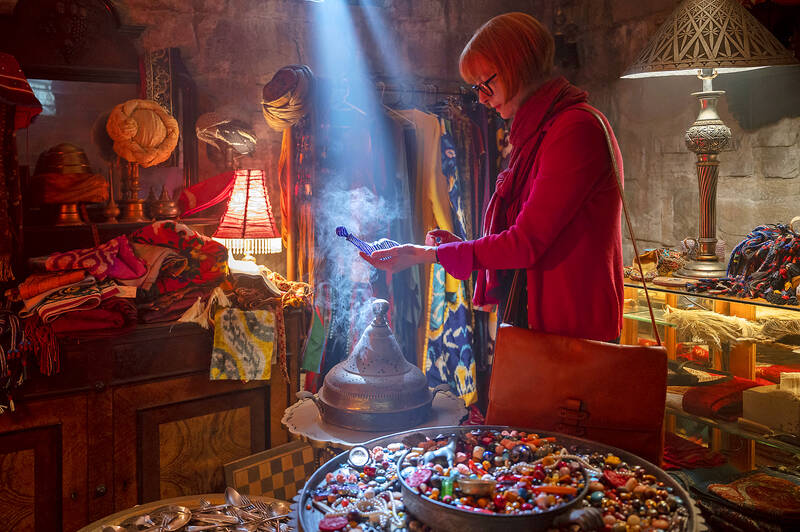There is not a cynical molecule in the makeup of George Miller’s Three Thousand Years of Longing, a patient and occasionally dazzling fantasy about love, myth, hope, companionship and perhaps, most of all, about storytelling. Idris Elba and Tilda Swinton, wrapped in plush white bathrobes, will reiterate the storytelling point over and over again during a vulnerable, sprawling conversation in a stately Istanbul hotel suite that’s nice enough to make one consider a career in academia.
Though the setting and wardrobe might feel familiar, this story is anything but. Only one of the parties, Swinton’s Alithea Binnie, is human. Elba is an immortal djinn, the fancy term for the anglicized “genie,” whom Alithea has stumbled upon in a small, striped glass bottle in an unsorted bin of an Istanbul antique store.
In most stories, the ability to suddenly get your heart’s desire with a wish comes as good news, at least at first. But Alithea isn’t one who has a list of wants. Not only is she a proud, contented single and child-free woman — she’s also a “narratologist” who is so well-versed in mythology that she knows all the ways in which wish-making and granting can go wrong. And yet by not fulfilling her duty to make three wishes, she also is condemning the djinn to nonexistence. He tries to convince her otherwise, by telling fantastical stories from his past, spanning some three thousand years, and all the times he was sent back to the bottle for caring too much about the wisher, from Sheba (Aamito Lagum), to a servant who longs for a prince, Gulten (Ece Yuksel), and finally child bride of an old merchant who desires knowledge, Zefir (Burcu Golgedar).

Photo: AP
These stories are enchanting, brutal, sensual, grotesque and often involve power struggles and irrational decisions made for love. Miller gets to play in a wide array of cultures as the djinn skips through time, all with their own shimmering palettes and fairy tale hyperrealism. It’s a nice reminder that Miller is a man who can tackle both Mad Max: Fury Road and Babe: Pig in the City.
At times, you may grow impatient wondering what it’s all building towards and if you even care, as Alithea doubles down on her stance that she’d rather not make any wishes at all. But she, and the audience, are in for a surprise. It’s the kind of moment that doesn’t make a lot of emotional sense on paper, but that’s why we go to the movies, isn’t it? Swinton and Miller make it work.
Still for all its romanticism, the film may also sit upon an uneasy foundation: The inglorious trope of the “magical, mystical Negro.” The term was popularized by Spike Lee, who in a lecture to Yale students over 20 years ago identified a trend exemplified in films like The Legend of Bagger Vance and The Green Mile in which the powers belonging to black characters, often exoticized, seem to only be used to benefit white characters. No matter how the various films try to justify it, the relationship, as Matt Zoller Seitz later wrote in Salon, “is that of a master and servant.”

Photo: AP
You don’t get a more literal depiction of master and servant than that of genie and the person who released them, and here, the fact is that the djinn is black and the human is white. But Three Thousand Years of Longing does not seem like the kind of movie that is internationally embracing this idea. One could even argue that Elba’s djinn exists outside of race somehow. Would it have made a difference if he was blue?
Or perhaps the phrase, like the Bechdel Test, was never supposed to be a literal line of demarcation between movies that are acceptable and movies that are not, but a way of talking about representation and, yes, storytelling. Maybe, like Swinton herself once said when faced with criticisms around the race of another fictional character, it can all be true.

Photo: AP

Photo: AP

June 9 to June 15 A photo of two men riding trendy high-wheel Penny-Farthing bicycles past a Qing Dynasty gate aptly captures the essence of Taipei in 1897 — a newly colonized city on the cusp of great change. The Japanese began making significant modifications to the cityscape in 1899, tearing down Qing-era structures, widening boulevards and installing Western-style infrastructure and buildings. The photographer, Minosuke Imamura, only spent a year in Taiwan as a cartographer for the governor-general’s office, but he left behind a treasure trove of 130 images showing life at the onset of Japanese rule, spanning July 1897 to

One of the most important gripes that Taiwanese have about the Democratic Progressive Party (DPP) is that it has failed to deliver concretely on higher wages, housing prices and other bread-and-butter issues. The parallel complaint is that the DPP cares only about glamor issues, such as removing markers of Chinese Nationalist Party (KMT) colonialism by renaming them, or what the KMT codes as “de-Sinification.” Once again, as a critical election looms, the DPP is presenting evidence for that charge. The KMT was quick to jump on the recent proposal of the Ministry of the Interior (MOI) to rename roads that symbolize

On the evening of June 1, Control Yuan Secretary-General Lee Chun-yi (李俊俋) apologized and resigned in disgrace. His crime was instructing his driver to use a Control Yuan vehicle to transport his dog to a pet grooming salon. The Control Yuan is the government branch that investigates, audits and impeaches government officials for, among other things, misuse of government funds, so his misuse of a government vehicle was highly inappropriate. If this story were told to anyone living in the golden era of swaggering gangsters, flashy nouveau riche businessmen, and corrupt “black gold” politics of the 1980s and 1990s, they would have laughed.

Imagine being able to visit a museum and examine up close thousand-year-old pottery, revel alone in jewelry from centuries past, or peer inside a Versace bag. Now London’s V&A has launched a revolutionary new exhibition space, where visitors can choose from some 250,000 objects, order something they want to spend time looking at and have it delivered to a room for a private viewing. Most museums have thousands of precious and historic items hidden away in their stores, which the public never gets to see or enjoy. But the V&A Storehouse, which opened on May 31 in a converted warehouse, has come up